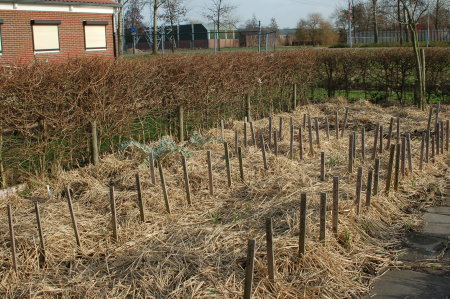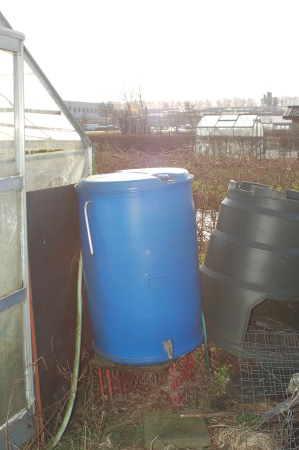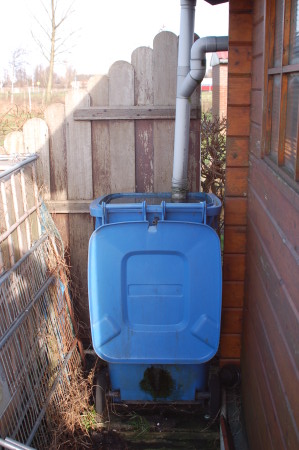Kelly of Future House recently did a great series of posts about the rain water collection system they built. He mentioned he used PVC pipes to build the system, which is what gave me the idea for this post.
Two Kinds of Chlorine
There are two kinds of chlorine, and the difference between them is very important.
The first kind is ordinary pure chlorine, sometimes called household chlorine, and is what common bleach is made from. This is also sometimes used in swimming pools, or added to drinking water. While there can be health issues with this type of chlorine, in particular both high concentrations and chlorine gas can be toxic and some people can have allergies to it, but overall it is considered very safe both for people and the environment. This type of chlorine occurs naturally in the environment, so moderate use is generally considered to be 100% biodegradable.
The other kind of chlorine is what is used in manufacturing processes. This is also sometimes called elemental chlorine, and this is what happens when atoms of chlorine are combined with other elements. One of the most important characteristics of these compounds is they are usually very long lived in the environment, and sometimes very toxic. Some common examples we are probably all familiar with are ozone depleting CFCs, PCBs which are very toxic, DDT as well as a number of other pesticides that have now been mostly banned (these are sometimes referred to as POPs or Persistent Organic Pesticides) and also PVC plastic.
These chlorine based compounds are so damaging to the environment, they have frequently been the focus of Greenpeace actions. Together with nuclear waste and heavy metals, chlorine compounds are some of the most serious environmental contaminants in the world now.
The Good
Household bleach really has many uses in the garden as well as in the house. Many people think of it as a harsh cleaner, because it smells so strong, but this is not actually the case. It’s a great environmentally friendly cleaner to use for the toilet, and is perfectly safe for septic tanks or for grey water collection systems to be used for plant irrigation. It is a much better alternative to bathroom scrubbing powders or creams, which are mostly very bad for the environment.
While you should never apply it in any way to plants or your garden, it’s very useful to clean greenhouses, tools, pots, seed trays and so on. It’s a very good disinfectant and can be very important in preventing the spreading of plant diseases. When you are done using it, it can be poured down the drain or on an unused spot in the garden. Within 48 hours it will completely break down into the environment.
The Not So Good
Most of us have something made from PVC plastic in the garden. Plastic coated fence or tools, maybe irrigation pipes. It can be really great stuff because, by design, it really does stand up to sunlight and last forever.
If you ever look into alternatives, you will see there aren’t many. Galvanized steel is sometimes used, but it contains trace amounts of heavy metals that will stay in your garden after the original material decomposes.
The main problem with using PVC in the garden is that it will be around long after you throw it away. It’s a very difficult plastic to recycle, if it’s incinerated or heated to a high temperature it will decompose into PCBs and if it is put into a landfill it will stay a very, very long time. While other kinds of plastics may be around for decades or maybe even centuries, PVC will likely be around a lot longer. When you think it will probably stay in your garden for 10-20 years, that’s a small percentage of it’s total lifespan.
Kelly of Future House asked the question if there were environmental problems with the manufacture of PVC. As far as I’m aware, there is no harmful waste created in the manufacture of it, but this is only half the equation! You should consider how what you buy will be disposed of, and if there are more environmentally friendly alternatives. Until now we have all been taught not to worry about what you throw away, and that what can be disposed of now can be dealt with by some future technology that will be soon developed. Not all of these technologies are emerging, and toxic waste and landfill space are already becoming serious problems.
Specifically addressing Kelly’s rain harvester system, what they might have used instead of PVC were metal fittings connected with rubber or plastic hose. Yes, it almost certainly would have leaked from time to time, and not worked as well, but it would have been easier to dispose of or recycle the individual components. It may also be possible to design a system where a single leak wouldn’t be as catastrophic as it would be in their system, perhaps top filling the barrels and having a separate tap on each one, maybe connecting the barrels in pairs or groups instead of all together. Another possibility might have been to try to use second hand PVC fittings, but I guess this would have been very difficult to do.




